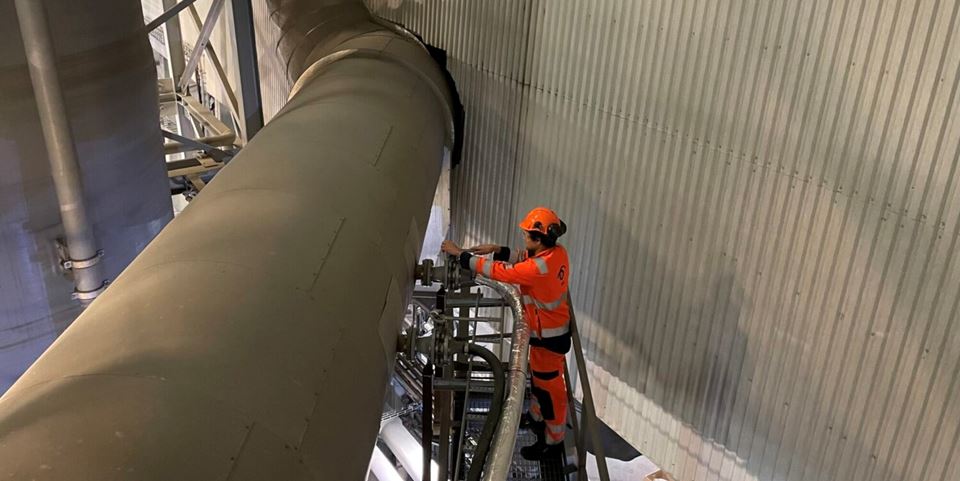Climate change mitigation technology. Flue gases from industrial plants contain the greenhouse gas CO2. Carbon capture processes increase the concentration of the gas, enabling it to be utilised or stored.
However, carbon capture technologies rely on energy to release the CO2 after it has been captured. Normally, this process uses heat as its source of energy, and some industries are able to exploit available surplus heat. For others, however, carbon capture requires complicated retrofitting or modifications to infrastructure, and incurs increased fuel costs.
Optimising energy consumption
A team of researchers at SINTEF has recently developed a new and simpler technology, called CSAR, for the capture of CO2 from industrial flue gases. CSAR stands for Continuous Swing Adsorption Reactor. It is based on a heat pump, a vacuum pump and the efficient use of electricity.
“Our studies have shown that the CSAR technology competes very well with technologies that utilise heat. This applies in particular if reasonably-priced electricity from renewable sources is available.
The advantage is that both pumps require just a single conventional source of electricity. This makes the technology ideal for installation on existing plants.
Jan Hendrik Cloete is a Research Scientist at SINTEF and is happy to explain the process in more detail.
“The CSAR technology utilises two reactors in the capture process. The CO2 is initially captured in the first reactor by a sorbent, which binds the gas to its surface. This binding process occurs at low temperature and generates heat. The heat is then transferred to the other reactor, where it is used to release the CO2 from the sorbent, this time at a higher temperature. The heat pump is used to transfer the heat between the reactors, while the vacuum pump assists in releasing the CO2.
The combined action of the two pumps makes the transfer of heat very efficient, and is also the reason for the low levels of energy consumption involved in this technology.
Highly competitive
“Our studies have shown that the CSAR technology competes very well with other technologies that utilise heat”, says Cloete. “This applies in particular if reasonably-priced electricity from renewable sources is available”, he says.

Promising results: This is the BIR AS waste combustion plant outside Bergen, where the CSAR technology is being demonstrated. Photo: BIR
This summer, the CSAR technology was demonstrated by SINTEF and the Norwegian company Caox at the BIR AS waste combustion plant outside Bergen. Every year, BIR processes about 220,000 tonnes of household waste for electricity and district heat generation, resulting in the emission of 250,000 tonnes of CO2.
“After 100 hours of operation, we found that we were able to capture the same amount of CO2 from real exhaust gases as we had in our laboratory tests”, says Cloete. “This was an important step because it confirmed that the CSAR concept also works at an industrial setting. It also helped to boost confidence in our economic estimates”, he says.
The pilot reactor is designed to capture 100 kg of CO2 per day. BIR is working to install a facility designed to capture 100,000 tonnes of CO2 annually by 2030. It will achieve this using commercially available technologies. At the same time, the company is also considering the use of new and more efficient technologies, such as CSAR, for capture of the remaining CO2.

Researcher Schalk Cloete operating the CSAR pilot at BIR AS. Photo: SINTEF
Contributing to CCS technology development
Results from the BIR plant in Bergen are paving the way for scaling up the CSAR technology for application across a range of industries. The pilot reactor has now been returned for upgrading at SINTEF’s multiphase laboratory in Tiller outside Trondheim.
Following this, the plan is to install the pilot in a cement factory in Spain. This is part of an ongoing EU-funded project called CAPTUS, which is looking into sustainable methods for the capture and utilisation of CO2 from energy-intensive industries.
Key facts:
- SINTEF has been collaborating with the Norwegian company Caox to develop the CSAR technology as part of a so-called CLIMIT-Demo project.
- The project is being funded by Caox and CLIMIT/Gassnova SF. The company BIR AS is acting as an industrial project partner.
Caox, which holds the global commercial licence to the technology, is currently planning to establish a scaled-up demonstration plant that can capture CO2 at a rate of three tonnes per day.


